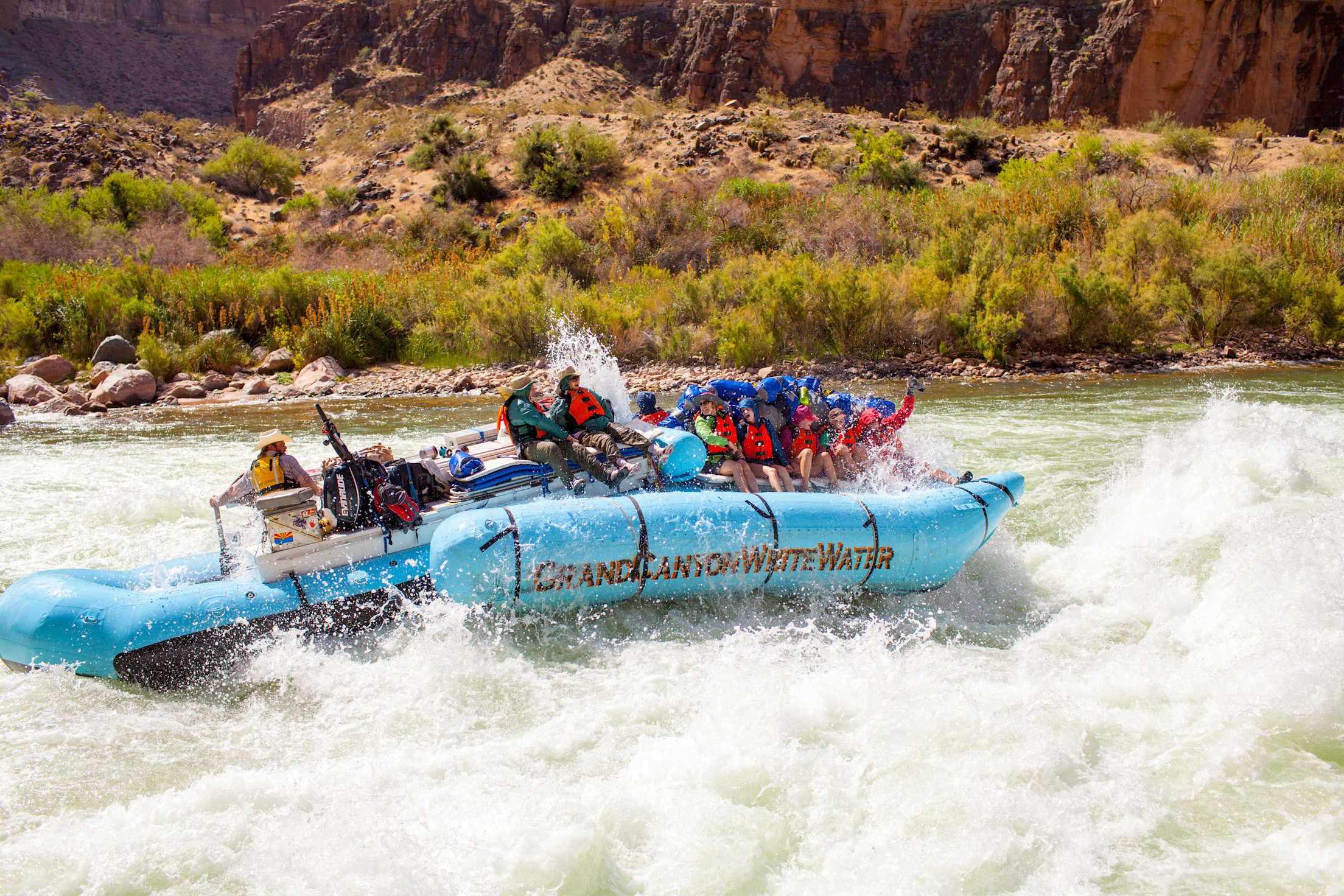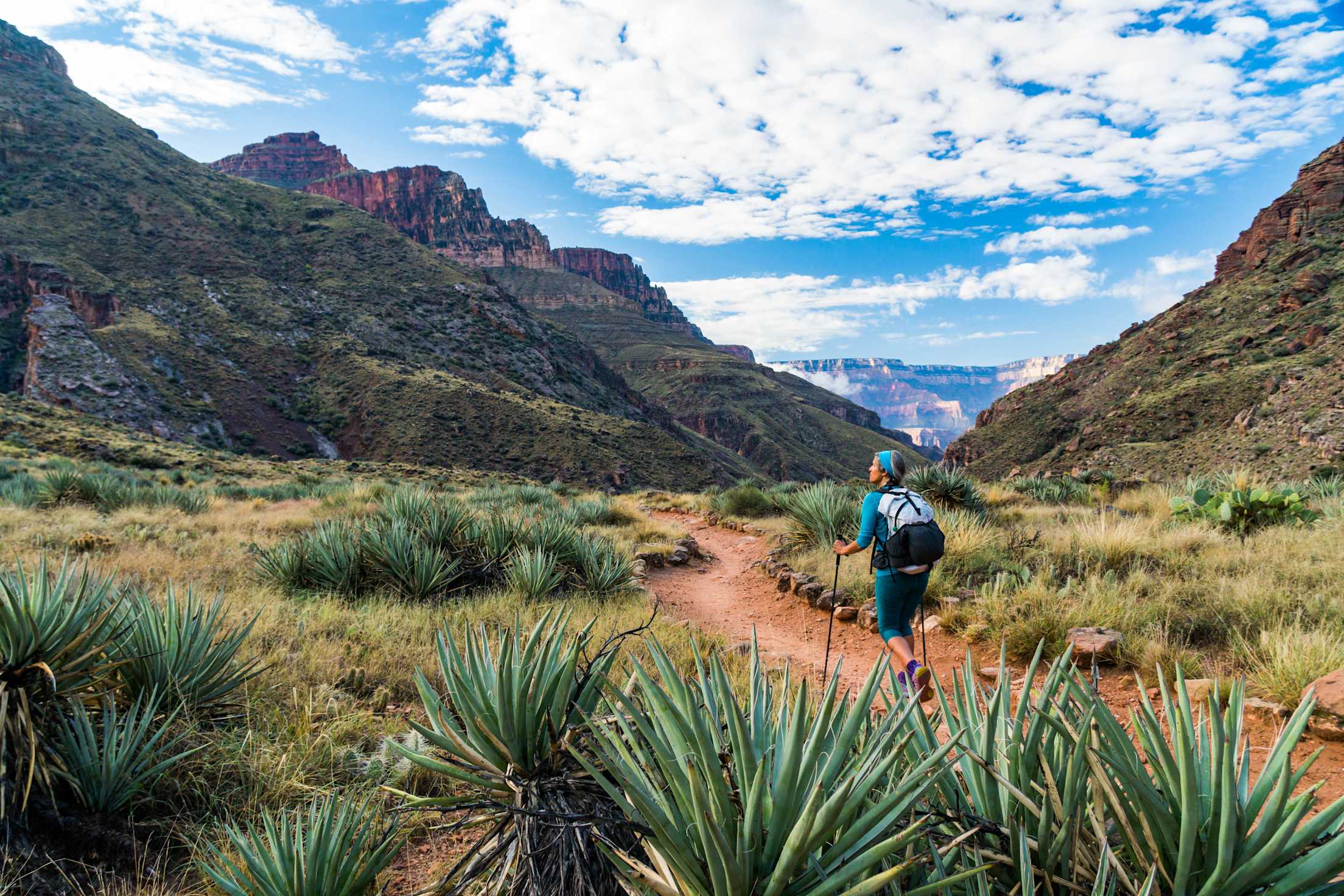
Complete Guide to Grand Canyon National Park
Hike with bighorn sheep, stargaze, and cycle to jaw-dropping viewpoints at this beloved Northern Arizona wonder.

Editor’s Note: As of July 2025, the North Rim developed area is closed to all visitor use due to the Dragon Bravo wildfire. Check the Grand Canyon National Park website for the latest information.
The Grand Canyon was born from billions of years of drama. Some of the rocks in the inner gorge are nearly half the age of the Earth. The multilayered, ivory and sienna cliffs record hundreds of millions of years of shifting ecosystems, from shallow seas to windswept sand dunes. Forces of destruction and creation combined to form the chasm’s sculptural shapes: Tectonic plates collided. The planet’s crust uplifted. The roaring Colorado River sliced through the sandstone. And snow, ice, and rain whittled spectacular spires.
It’s no wonder so many people have been drawn to the canyon’s beauty, natural abundance, and promise of adventure. Since time immemorial, Indigenous peoples have inhabited and cared for this marvel of nature. Today, 11 tribes have connections to the canyonlands and work in partnership with the park as stewards of the landscape and cultural traditions.
Starting in the mid 1500s, Europeans and Euro-Americans explored the area. The most famous was one-armed Civil War veteran John Wesley Powell, who navigated the Colorado River from Wyoming through the Grand Canyon in two harrowing and disaster-riddled expeditions. In the decades that followed, miners, entrepreneurs, and artists made their mark on the canyon. The intrepid Kolb brothers captured its splendor on camera, and architect Mary Colter designed eight buildings that mimic the surrounding geology. Their works can still be seen today.
Though it seems obvious the Grand Canyon is worth protecting, the U.S. government took 37 years to designate the site a national park after a bill was first proposed in 1882. At the time, interest groups were targeting this majestic wilderness for mining, timber, and ranching. Thankfully, the burgeoning conservation movement prevailed, and the Grand Canyon was designated a national park in 1919. Today, around 4.75 million people visit the canyon each year to hike, whitewater raft, and bask in the awe-inspiring scenery.

Top Attractions
At 277 miles long, up to 18 miles wide, and a mile deep, the Grand Canyon offers countless corners to explore. Travelers can venture into the national park at two entrances, the South Rim and the North Rim. Grand Canyon West is not part of the national park but is located on Hualapai Indian Tribal Lands. Here, daring travelers can peer into the chasm through a glass Skywalk or ride the Colorado’s rapids on a one- or two-day rafting trip.
Around a four-hour drive from Phoenix or a roughly five-hour drive from Las Vegas, the South Rim is the most accessible and popular part of the park. Most of the photographs you’ve seen were captured here at lookouts like Mather Point and Hopi Point. Though the viewpoints nearest to the park entrance can get crowded, you typically don’t have to stroll far along the flat, mostly paved, 13-mile Rim Trail to savor relative quiet with panoramic views. Visitors to the South Rim can also tour the art exhibits at Kolb Studio, the former Victorian era home of the photographer brothers. In addition, a free shuttle bus whisks visitors to trailheads, lookouts, lodges, and the Yavapai Geology Museum.
The drive to the remote North Rim takes about six hours from Phoenix or less than five hours from Las Vegas. But you’ll be rewarded with a sparsely touristed setting where you can breathe pine-crisp air and meditate upon vast canyon views framed by ponderosa forest.

What To Do
At both the North and South Rim, rangers lead talks about topics including geology, history, astronomy, and California condors—the endangered but recovering birds that soar from the South Rim’s cliffs. In addition, American Indian artists frequently share their culture and creativity at the South Rim visitor center; past artisans have included a Navajo painter and a Hopi silversmith.
To hike into the canyon at the South Rim, set off on Bright Angel Trail, a cliff-hugger famous for stunning scenery, countless switchbacks, and bighorn sheep encounters. You can turn around anytime on the 12-mile round-trip trek, but remember to be kind to your future self: Every step down means a step up on the way back. For family-friendly fun, Bright Angel Bicycles rents cruisers and e-bikes, plus hosts cycling tours along Hermit Road, where you can pedal past prancing deer and breathtaking vistas.
At the North Rim, descend into the gorge on the challenging North Kaibab Trail, where pines poke up from vertiginous, rainbow-colored cliffs. Popular turnaround points are Coconino Overlook or Supai Tunnel, 1.5 miles and 4 miles roundtrip, respectively. Rest your feet and cruise the 46-mile round-trip Cape Royal Road, taking in top-of-the-world panoramas at Point Imperial, picnicking at Vista Encantada, and enjoying peekaboo views of the Colorado River through Angels Window natural arch.
The canyon is an officially designated Dark Sky Park, and for one week every June, both Rims host the Grand Canyon Star Party. Visitors can gaze at galaxies through telescopes and take workshops on night sky photography with amateur astronomers. Every September, the Grand Canyon Music Festival brings string quartets, jazz musicians, and more to the South Rim.
When to Go
The South Rim stays open year-round, though some services—such as bicycling tours and two shuttle bus routes—may not be available in the winter, depending on the weather. Spring and autumn are the best times to visit, when daytime temps might average in the 60s, and wildflowers or fall foliage splash color onto the scenery. At night, temperatures might fall below freezing, so bring warm layers of clothing. In the more crowded summers, the mercury typically tops in the 100s. But if you hike into the canyon, remember that the temperature rises as you descend, heat radiates off the rocks, and you’ll generate your own warmth through exertion, so it can feel like it’s a lot hotter. Check current conditions before you go to ensure you are properly prepared.
The North Rim is typically open from May 15 through October 15. With summer temperatures ranging from the 40s at night to the 70s in the day, this rim makes a refreshing escape from the Southwest’s sweltering heat. In fall, temps span from the 30s to the 60s, and aspens light up the landscape with their golden leaves and silvery bark.

Where to Camp and Stay
Of the South Rim’s five lodges, the most legendary is El Tovar, a 1905 hotel built from local limestone and Oregon pine, spruced up with European flair. Here, you can stay where Theodore Roosevelt and Albert Einstein slept, and dine in splendor by a lawn where mule deer sometimes graze. For a more minimalist experience, Mather Campground at the South Rim’s Grand Canyon Village offers 327 sites, each with a campfire ring/cooking grate, picnic table, and parking. The campground also has flush toilets and drinking water.
Since the Grand Canyon Lodge was destroyed in the Dragon Bravo wildfire in July 2025, there are no hotels at the North Rim. The North Rim Campground (typically open May 15 through October 15)—where you’ll find 87 sites, a camp store, showers, toilets, and water—is closed for the rest of the 2025 season due to the fire.
Remember, Tread Lightly
Millions of people visit the Grand Canyon every year, and their collective actions can seriously damage fragile desert ecosystems. Practice these Leave No Trace principles to protect the sensitive environment. Stay on the trails, dispose of waste properly, leave rocks and plants where they are, minimize campfire impact, and respect wildlife.